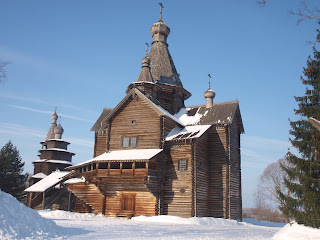This past weekend, I went on an excursion to the historical, medieval city of Novgorod the Great (Великий Новгород Veliky Novgorod). The city was founded in the 9th or 10th Century around the time Christianity was founded in Kievan Rus (around 988). At this time, Kievan Rus was controlled by the Rurik Dynasty. It was a capital and a major center of trade, commerce, politics, and culture before Saint Petersburg was established in the early 18th Century. The oldest church in Russia, Saint Sofia's Cathedral, built between 1045 and 1050, still stands today.
Our transport to Novgorod from Saint Petersburg was by bus on Russia's M10 highway that ultimately leads to Moscow. The highway was in better condition than I expected it would be, but there were many vehicles that were off the road in a less than perfect state. A small truck also happened to spin out in front of our bus, but managed to correct itself before sliding off the road. It was interesting to view the Russian countryside and the villages and Russian Orthodox churches that dot the landscape along the highway. Three and a half hours later, we finally arrived in Novgorod, checked into our hotel, and had lunch.
Then, we embarked on a walking tour of the central, medieval district of the city. As I stated above, we visited the Novgorod Kremlin home to the oldest church in Russia and the Monument to the Millennium of Russia built in 1862. The monument includes significant events and important people - political, religious, and cultural - throughout Russian history. At this particular point on the monument pictured below, near the top, you can see such depictions as the Christianization of Rus in 988, and the beginnings of the Romanov Dynasty in 1613.
Then, we embarked on a walking tour of the central, medieval district of the city. As I stated above, we visited the Novgorod Kremlin home to the oldest church in Russia and the Monument to the Millennium of Russia built in 1862. The monument includes significant events and important people - political, religious, and cultural - throughout Russian history. At this particular point on the monument pictured below, near the top, you can see such depictions as the Christianization of Rus in 988, and the beginnings of the Romanov Dynasty in 1613.
We also stopped to see the magnificent Znamenskiy Cathedral built in the 16th Century.
I would like to note, that at one time, Novgorod had around thirty monasteries. Now, only seven remain, but there are still almost too many churches to count.
The night at the hotel was quite rowdy. My sleep was disrupted at least three times due to people running back and forth down the hall, and also by people conversing quite loudly. This was the only incident with which I was frustrated on this trip. However, in the morning, after breakfast, I decided to venture off by myself and walked to Novgorod's Saint Sofia Square, also known as Victory Square in the Soviet times, where I was able to have a moment alone with Lenin.
After checking out of the hotel around noon, we set off on the second part of our excursion: touring the Sviato-Yurievskiy working monastery and the Vitoslavitsy Russian village. At the monastery, because it was active, all the females in the group had to cover their heads and the males had to remove their hats. The monastery was absolutely beautiful.
The Georgievskiy Cathedral, built in the 12th Century, is where the burial vault of the Novgorod princes is located.
After visiting the monastery, we headed to the Vitoslavitsy Russian Village from the 16th to the 18th Centuries built entirely out of wood. It was fascinating to see the intricacies of the structures built, to learn about Russian village life from that period, and to view in person the wooden designs that date back to pagan Russia. Despite the cold, I was really happy to be there, and I just had to smile when the Russian Orthodox pealing of the bells tolled through the village. It was a magical moment.
Lunch was at a nearby restaurant that served Russian cuisine, and I must say that the food was delicious. I had borscht with sour cream, potatoes with sour cream, blinys (thin pancakes) with sour cream (yes, Russians like their sour cream), cutlet, and tea with a spot of jam. I left Novgorod very satisfied.
On our return journey to Saint Petersburg, colloquially known as Piter, there were issues with the tour bus. The engine had some sort of mechanical problem and the engine was overheating, so the bus kept having to pull over to the side of the road every five to ten minutes or so for the first hour in order for the engine to cool down. We were going to have to transfer buses halfway through the journey. Luckily, the problem seemed to have resolved enough to the point where we could remain on the same bus and return safely to Piter. I find it fitting, that as we drove through the Russian countryside and entered the city of Petersburg four and a half hours later, I was listening to the Red Army Choir.

















No comments:
Post a Comment